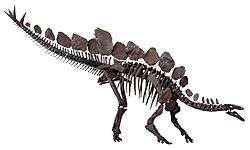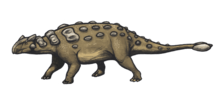Stegosauridae
| Stegosaurids Temporal range: Middle Jurassic - Early Cretaceous, 160–136 Ma | |
|---|---|
 | |
| Mounted skeleton of Stegosaurus stenops, Natural History Museum, London | |
| Scientific classification | |
| Kingdom: | Animalia |
| Phylum: | Chordata |
| Order: | †Ornithischia |
| Clade: | †Eurypoda |
| Suborder: | †Stegosauria |
| Family: | †Stegosauridae Marsh, 1880 |
| Type species | |
| †Stegosaurus stenops Marsh, 1877 | |
| Subgroups | |
| |
Stegosauridae is a group of armored dinosaurs comprising all species more closely related to Stegosaurus than to Huayangosaurus.[1] Their fossil range extends into the early Cretaceous period, exceeding that of other stegosaurians, such as the huayangosaurids, which had died out by the end of the Jurassic. Stegosaurids are characterized by rows of plate-like osteoderms arranged vertically along the neck, body, and tail, which graded with varying abruptness into a series of spikes.[2] These may have had a number of uses: display and/or thermoregulation are likely functions for the plates, while evidence suggests that the spikes were used at least partly for defense.[3][4][5]
Paleobiology

General anatomy
Stegosaurids were large and powerful dinosaurs. Their front legs were shorter than their rear, making them slow-moving. When Othniel Charles Marsh first found Stegosaurus, he portrayed the animal with very short front legs and neck, though new evidence shows that some species had relatively long front limbs.[6] Several species show sexual dimorphism in the sacrum with the putative female having an extra pair of sacral ribs. There are also two sizes of parascapular spines in Lexovisaurus which can be ascribed to such variation.[3][7]
Bite
In 2010 Míriam Reichel, using the 3D-modelling software ZBrush, created two digital models of Stegosaurus teeth differing in the presence or not of serrations. She found that Stegosaurus likely had beaks (rhamphotheca). She also found that stegosaurs were capable of shearing small branches, and suggested that the same data could be applied to other stegosaurids.[8]
Evolution and classification
In contrast with early stegosaurians, like Huayangosaurus, stegosaurid skulls are shallower and the difference between the long hindlimb and short forelimb larger.[2] The osteoderms of stegosaurids can attain a large size either as the broad plates of Stegosaurus or the long spikes of Kentrosaurus.[6]
The earliest stegosaurian is thought to be Lexovisaurus[9] from the Bathonian of England. There was found a massive femur of the juvenile Lexovisaurus. The youngest is Dravidosaurus from the Coniacian of India. Possible Maastrichtian stegosaurids may also exist in Indian deposits, but these fossils have not been described.[10][11]
Stegosauridae was first defined by Paul Sereno in 2005 as the most inclusive clade containing Stegosaurus stenops but not Huayangosaurus taibaii. It is divided into two subfamilies: Dacentrurinae and Stegosaurinae.[12] The subfamily Stegosaurinae was first recognized by Nopcsa in 1915. It comprises, according to the definition of Sereno (1998), the eponymous Stegosaurus and all stegosaurids more closely related to it than to Dacentrurus. A second subfamily, the Dacentrurinae, was proposed by Mateus et al. (2009) to include Dacentrurus and all stegosaurids closer in relation to it than to Stegosaurus.[13][14]
More primitive stegosaurids, like Lexovisaurus, Kentrosaurus, and Tuojiangosaurus, are characterized by the comparatively large osteoderms running along their backs and reduced lateral osteoderms. Contrasting with the abrupt transition from plate to spike in stegosaurines, primitive stegosaurids have their plates grade into spines in a zone with osteoderms showing an intermediate shape.[2][15]
The cladogram below follows an analysis by Mateus et al. (2009).[13]
| Stegosauria |
| |||||||||||||||||||||||||||||||||||||||||||||||||||||||||||||||
| |
See also
References
- ↑ Galton, Peter; Paul Upchurch (2004). "16: Stegosauria". In David B. Weishampel, Peter Dodson , Halszka Osmólska. Dinosauria (2nd ed.). Berkeley: University of California Press. p. 358.
- 1 2 3 Sereno, Paul C. (1999-06-25). "The Evolution of Dinosaurs". Science 284 (5423): 2137–2147. doi:10.1126/science.284.5423.2137. PMID 10381873.
- 1 2 Galton, Peter; Paul Upchurch (2004). "16: Stegosauria". In David B. Weishampel, Peter Dodson , Halszka Osmólska. Dinosauria (2nd ed.). Berkeley: University of California Press. pp. 361–362.
- ↑ Hayashi, Shoji; Kenneth Carpenter; Mahito Watabe; Lorrie A. Mcwhinney (2011). "Ontogenetic Histology of Stegosaurus Plates and Spikes". Palaeontology (The Palaeontological Association) 55 (1): 145–161. doi:10.1111/j.1475-4983.2011.01122.x.
- ↑ "Stegosaur plates used for identification". National Geographic website. National Geographic News. 25 May 2005. Retrieved 2006-10-26.
- 1 2 Galton, Peter (1997). "21: Stegosaurs". In James O. Farlow, M. K. Brett-Surman. The Complete Dinosaur. Bloomington: Indiana University Press. ISBN 9780253213136.
- ↑ Barden, Holly E.; Maidment, Susannah C. R. (May 2011). "Evidence for sexual dimorphism in the stegosaurian dinosaur Kentrosaurus aethiopicus from the Upper Jurassic of Tanzania". Journal of Vertebrate Paleontology 31 (3): 641–651. doi:10.1080/02724634.2011.557112.
- ↑ Reichel, Miriam (2010). "A model for the bite mechanics in the herbivorous dinosaur Stegosaurus (Ornithischia, Stegosauridae)". Swiss Journal of Geosciences 103 (2): 235–240. doi:10.1007/s00015-010-0025-1.
- ↑ Peter M. Galton and H. Philip Powell. "Stegosaurian Dinosaurs from the Bathonian(Middle Jurassic) of England, the earliest record of the family Stegosauridae".
- ↑ The Dinosauria: Second Edition
- ↑ Galton and Upchurch (2004); "Introduction", page 343.
- ↑ Thomas R. Holtz, Jr. (2007). Dinosaurs: The Most Complete, Up-to-Date Encyclopedia for Dinosaur Lovers of All Ages (PDF). Random House.
- 1 2 Mateus, Octávio; Maidment, Susannah C.R.; Christiansen, Nicolai A. (2009). "A new long-necked 'sauropod-mimic' stegosaur and the evolution of the plated dinosaurs" (pdf). Proceedings of the Royal Society B: Biological Sciences 276 (1663): 1815–21. doi:10.1098/rspb.2008.1909. PMC 2674496. PMID 19324778.
- ↑ J.I.Ruiz-Omeñaca. "New stegosaurian (Ornithischia, Thyreophora) remains from Jurassic-Cretaceous transition beds of Valencia province (Southwestern Iberian Range, Spain)".
- ↑ Sereno, Paul C.; Zhimin, Dong (1992). "The skull of the basal stegosaur Huayangosaurus taibaii and a cladistic diagnosis of stegosauria". Journal of Vertebrate Paleontology 12 (3): 318–343. doi:10.1080/02724634.1992.10011463.
| ||||||||||||||||||||||||||||||||||||||||||||||||||||||||||||||||||||||||||||||||||||||||||||||||||||||||||||||||||||||||||||||||||

